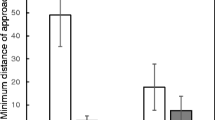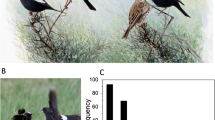Abstract
Data on intermale social relations and troop membership changes in one Nepalese high-altitude population of free-ranging langurs (Presbytis entellus)are reported here. Data were collected from six troops by three observers and cover 32 months of observations. The predominantly multi-male troops indicate an alternating pattern of exclusions and introductions with gradual adult male replacement. Takeovers and infant killing were not observed. Analysis of adult social behavior records show qualitative and quantitative differences in intrasexual relations, with primarily agonistic social contacts occurring between males. Agonistic encounters between females and between males differ in frequency of occurrence, types of be-haviors used, cause, and consistency in direction of threats between individuals. Individual adult male frequency of interaction with females and immatures varied significantly, with the majority of these interactions occurring between the dominant troop male and other troop members. Data indicate that intermale dominance is a major factor in determining male access to fertile females: This appears to be achieved by either directly excluding males from the troop or effectively “controlling” their inter-actions with troop females. Data from these studies are compared with data from other Presbytis entellusinvestigations. Review of these data suggests that intraspecific variability in intermale social dynamics and type of troop male membership change are correlated with the percentage of nontroop males. It is suggested that environmental pressures resulting in social crowding can be critical in determing the occurrence of takeovers in some populations of Presbytis entellus.
Similar content being viewed by others
References
Altman, J. (1974). Observational study of behavior: Sampling methods.Behavior 48: 1–41.
Bishop, N. H. (1975).Social Behavior of Langur Monkeys (Presbytis entellus) in a High Altitude Environment, Unpublished Ph.D. thesis, University of California, Berkeley.
Bishop, N. H. (1979). Himalayan langurs: Temperate colobines.J. Human Evolut. 8: 251–281.
Bishop, N. H., Hrdy, S. B., Moore, J., and Teas, J. (1980). Qualitative and quantitative definitions of human influence in habitats of south Asian monkeys (in press).
Boggess, J. E. (1976).The Social Behavior of the Himalayan Langur (Presbytis entellus) in Eastern Nepal, Unpublished Ph.D. thesis, University of California, Berkeley.
Boggess, J. E. (1979). Troop male membership change and infant killing in langurs (Presbytis entellus).Folia Primatol. 32: 65–107.
Curtin, R. A. (1975).The Socioecology of the Common Langur, (Presbytis entellus), in the Nepal Himalaya, Unpublished Ph.D. thesis, University of California, Berkeley.
Curtin, R. A. (1977). Langur social behavior and infant mortality.Kroeber Anthropol. Soc. Papers 50: 27–36.
Curtin, R. A., and Dolhinow, P. (1978). Primate social behavior in a changing world.Am. Sci. 66: 468–475.
Eisenberg, J. F., Muckenhem, N. A., and Rudran, R. (1972). The relation between ecology and social structure in primates.Science 176: 863–874.
Hrdy, S. B. (1974). Male-male competition and infanticide among the langurs (Presbytis entellus) of Abu, Rajastan.Folia Primatol. 22: 19–58.
Hrdy, S. B. (1977a). Infanticide as a primate reproductive strategy.Am. Sci. 65: 40–49.
Hrdy, S. B. (1977b).Langurs of Abu: Female and Male Strategies of Reproduction, Harvard University Press, Cambridge, Mass.
Hrdy, S. B. (1979). Infanticide among animals.Ethol. Sociobiol. 1: 13–40.
Jay, P. C. (1962).The Social Behavior of the Langur Monkey, Unpublished Ph.D. thesis, University of Chicago, Chicago.
Jay, P. C. (1965). The common langur of north India. In DeVore, I. (ed.),Primate Behavior, Hot, Rinehart and Winston, New York, ppo. 197–300.
Makwana, S. C. (1979). Infanticide and social change in two groups of the Hanuman langur (Presbytis entellus), at Jodhpur.Primates 20(2): 293–300.
Mohnot, S. M. (1971a). Some aspects of social change and infant-killing in the Hanuman langur,Presbytis entellus (Primates: Cercopithecidae) in western India.Mammalia 35: 175–198.
Mohnot, S. M. (1971b). Ecology and behavior of the Hanuman langur,Presbytis entellus (Primates: Cercopithecidae) invading fields, gardens and orchards around Jodhpur western India.Trop. Ecol. 12(2): 237–249.
Mohnot, S. M. (1974).Ecology and behavior of the Common Indian Langur, Presbytis entellus Dufresne, Unpublished Ph.D. thesis, University of Jodhpur, India.
Oppenheimer, J. R. (1977).Presbytis entellus, the Hanuman langur. In Rainer, H. R. H., and Bourne, G. H. (eds.),Primate Conservation, Academic Press, New York, pp. 469–512.
Pocock, R. I. (1939).The Fauna of British India. Mammals, 2nd ed., Vol. 1, Taylor and Francis, London.
Poirier, F. E. (1970). The communication matrix of the Nilgiri langur (Presbytis johnii) of south India.Folia Primatol. 13: 92–136.
Puri, S. G. (1960).Indian Forest Ecology, Vol. 1 and 2, Oxford Book and Stationery, New Delhi.
Rahaman, H. (1973). The langurs of the Gir Sanctuary (Gujarat)-a preliminary survey.J. Bombay Nat. Hist. Soc. 70: 295–314.
Ripley, S. (1965).The Ecology and Social Behavior of the Ceylon Gray Langur, Presbytis entellus thersites, Unpublished Ph.D. thesis, University of California, Berkeley.
Rudran, R. (1973). Adult male replacement in one-male troops of purple-faced langurs (Presbytis senex) and its effect on population structure.Folia Primatol. 19: 166–192.
Stainton, J. D. A. (1972).Forests of Nepal, John Murray, London.
Starin, E. D. (1978). A preliminary investigation of home range use in the Gir Forest langur.Primates 19(3): 551–568.
Sugiyama, Y. (1964). Group composition, population density and some sociological observations of Hanuman langurs (Presbytis entellus).Primates 5: 7–38.
Sugiyama, Y. (1965a). Behavioral development and social structure in two troops of Hanuman langurs (Presbytis entellus).Primates 6: 213–247.
Sugiyama, Y. (1965b). On the social change of Hanuman langurs (Presbytis entellus) in their natural condition.Primates 6: 381–418.
Sugiyama, Y. (1966). An artificial social change in a Hanuman langur troop (Presbytis entellus).Primates 7: 41–72.
Sugiyama, Y. (1967). Social organization of Hanuman langurs. In Altmann, S. (ed.),Social Communication Among Primates, University of Chicago Press, Chicago, pp. 221–236.
Sugiyama, Y. (1976). Characteristics of the ecology of the Himalayan langurs.J. Human Evolut. 5: 249–277.
Sugiyama, Y., Yoshiba, K., and Parthasarathy, M. D. (1965). Home range, mating season, male group and intertroop relations in Hanuman langurs (Presbytis entellus).Primates 6: 73–106.
Vogel, C. (1971). Behavioral differences forPresbytis entellus in two different habitats.Proc. Third Int. Congr. Primatol. 3: 41–47.
Vogel, C. (1973). Hanuman as a research object for anthropologists-field studies of social behavior among gray langurs of India,Contributions to Indian Studies, Vol. 1, Cultural Department, Embassy of the Federal Republic of Germany, New Delhi, Chowkhamba Sanskrit Series Office, Varanasi.
Vogel, C. (1979). Der hanuman-langur (Presbytis entellus), ein parade-exempel fur die theoretischen konzepte der “sozdobiologie”?Verh. Deutche Zool. Gustave Fischer Verlag, Stuttgart, pp. 73–89.
Warren, J. M. (1967). Discussion of social dynamics. In Altmann, S. (ed.),Social Communication Among Primates, University of Chicago Press, Chicago, pp. 255–257.
Yoshiba, K. (1967). An ecological study of Hanuman langursPresbytis entellus.Primates 8: 127–154.
Yoshiba, K. (1968). Local and intertroop variability in ecology and social behavior of common Indian langurs. In Jay, P. (ed.),Primates: Studies in Adaptation and Variability, Holt, Rinehart and Winston, New York, pp. 217–242.
Author information
Authors and Affiliations
Rights and permissions
About this article
Cite this article
Boggess, J. Intermale relations and troop male membership changes in langurs (Presbytis entellus) in Nepal. Int J Primatol 1, 233–274 (1980). https://doi.org/10.1007/BF02692274
Received:
Issue Date:
DOI: https://doi.org/10.1007/BF02692274




